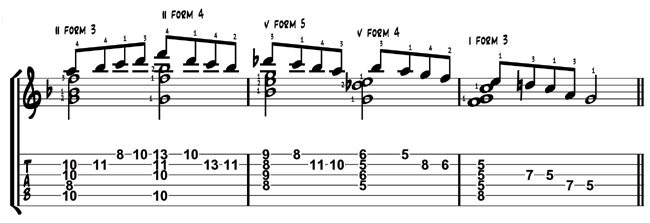Part One: Melody
Focuses on single note soloing. Learn how to effortlessly solo through complex chord changes.
Free Jazz Guitar Lessons with Chris Standring
Chord melody seems like quite a daunting concept to
many students. The very idea of improvising lines in chords might seem
overwhelming, but let me try to put this into a little perspective.
If I asked you to play a simple blues lick over say a G7 chord, or even
a G minor7 chord, you could probably do this very easily. How many licks
do you think you might be able to pull off? A fair few I'd like to think.
Now, if I asked you to play over a 2 - 5 - 1 chord progression in G,
how would you do? You could draw from a good deal of harmonic vocabulary
that you have studied, and perhaps that I have shown you.
We are building vocabulary to draw our ideas from. The more ideas you
play with, the more your internal database grows. And whatever you have
to play with can be put into other harmonic situations. Some things
you will learn stick with you, some don't. And this is perfectly fine.
Very often, technically difficult lines don't stay with you. This is
why I always like to develop ideas that sit nicely under the fingers.
That way I can work them into my playing naturally and I won't get 'taken
out of the moment' during improvisation.
So getting to my point. Chord melody is absolutely no different. We
are simply building more data to draw from. If I were to show you a
cool melodic line in G minor voiced over say the top four strings, at
the 3rd fret, you now have some chord melody to play over G minor. Learning
the vocabulary and internalizing it is the first step.
Of course, it's never quite that simple because, stylistically, these
lines need to come out naturally and in different settings and tempos.
For instance, how one interprets a line playing a ballad, might be very
different than playing it at mid tempo, and quite different at fast
tempo. And let's not forget different time signatures such as ¾
waltz time.
We need to study a little harmony, so we understand where the notes
come from, and then we need to look at lots of different examples so
you can start building your chord melody improvising vocabulary.
I remember Joe Pass once saying that there are only three chords to
be concerned with. Or more specifically, that he liked to reduce everything
to one of three chords for the purpose of practicality. And we are going
to look at things from the same perspective, because Joe was on to something.
You should know that the most important chord progression in jazz is
the TWO-FIVE-ONE chord progression. In any key this gives us a minor
chord, followed by a dominant chord, followed by a major chord. So let's
say in the key of F major, a two-five-one chord progression (adding
7ths to each chord) would be G minor7, going to C7, going to Fmajor7.
So how do we reduce everything to one of these three chords? Well, we
can assume that minor 6, minor 7 or minor 9 chords for example are simply
embellished minor chords. An altered dominant chord is an embellished
dominant. The only other two chords that we need to concern ourselves
with are diminished and augmented.
A diminished chord can simply be looked at as the top part of a dominant
7th chord. It contains all the notes of a dominant 7th chord with a
flattened 9th. It can of course be used as a stand-alone diminished
chord in itself, but for our purposes, it may be easier to think of
it as a relative to it's parent FIVE chord.
We can interpret augmented chords in a similar way. An augmented chord
is essentially a major triad with a raised fifth. Let's say we are in
the key of F major. If we add a 7th to a C augmented chord we get the
chord of C7(#5). Again, this is simply an embellishment of a dominant
7th chord.
So if we can reduce everything harmonically to just these three chords,
building our vocabulary is that much easier and more focused. In my
Jazz Guitar Video Masterclass Volume
2 (which is focused 100% on chord melody) I will show you a ton
of ideas you can play on each of these three chords. I will also show
you how to link each idea together.
To get your feet wet, let's look at three TWO-FIVE-ONE chord melody
ideas we can use utilizing some of the information I will show you in
my program. In these examples we are going to think of our FIVE chord
with a b9 on top. This produces a diminished sound. Here are my examples:



Free online jazz guitar lessons for beginners, intermediates and advanced.
Online jazz guitar instruction from recording artist Chris Standring
Join The Inside Track membership and get access to all Chris Standring's guitar instructional programs, all in one place.
It has been many years since the first edition of Play What You Hear (originally released in 2000). Now volume two is here with new ideas and concepts, complete with audio, video, traditional notation and TAB throughout. High resolution pdf available for printing the entire program. For intermediate and advanced players.
Focuses on single note soloing. Learn how to effortlessly solo through complex chord changes.
Focuses on chord melody. Learn new harmonic devices and understand chords in a whole new way.
Study Chris Standring's six recorded solos, transcribed with audio and high def video.
Copyright © PlayJazzGuitar.com - All Rights Reserved.